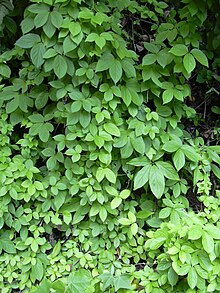Dioscorea pentaphylla is a species of flowering plant in the yam family known by the common name fiveleaf yam. It is native to southern and eastern Asia (China, India, Indochina, Indonesia, Philippines, etc.) as well as New Guinea, Sri Lanka and northern Australia. It is widely cultivated as a food crop and naturalized in Cuba and on several island chains in the Pacific (including Hawaii).[1][4][5][6][7][8][9][10][11][12]
| fiveleaf yam | |
|---|---|
 | |
| Scientific classification | |
| Kingdom: | Plantae |
| Clade: | Tracheophytes |
| Clade: | Angiosperms |
| Clade: | Monocots |
| Order: | Dioscoreales |
| Family: | Dioscoreaceae |
| Genus: | Dioscorea |
| Species: | D. pentaphylla |
| Binomial name | |
| Dioscorea pentaphylla | |
| Synonyms[1] | |
| |
| Nutritional value per 100 g (3.5 oz) | |
|---|---|
| Energy | 343 kJ (82 kcal) |
20 g | |
0.08 g | |
1.73 g | |
| Vitamins | Quantity %DV† |
| Thiamine (B1) | 7% 0.086 mg |
| Riboflavin (B2) | 1% 0.014 mg |
| Niacin (B3) | 1% 0.13 mg |
| Pantothenic acid (B5) | 10% 0.48 mg |
| Vitamin B6 | 12% 0.209 mg |
| Folate (B9) | 3% 12 μg |
| Minerals | Quantity %DV† |
| Iron | 2% 0.43 mg |
| Magnesium | 2% 10 mg |
| Manganese | 12% 0.283 mg |
| Phosphorus | 3% 40 mg |
| Potassium | 17% 495 mg |
| Sodium | 1% 12 mg |
| Zinc | 3% 0.32 mg |
| †Percentages estimated using US recommendations for adults,[2] except for potassium, which is estimated based on expert recommendation from the National Academies.[3] | |
Dioscorea pentaphylla is a prickly vine that twines counterclockwise around objects and other plants. It may reach 10 meters in length. The alternately arranged leaves are compound, divided into 3 to 5 leaflets each up to 10 centimeters long. The plant produces horseshoe-shaped bulbils about a centimeter long. New plants can sprout from the bulbils. Flowers are borne in spikes. The vine grows from a tuber. Specimens may weigh 3 pounds and may be located over a meter underground.[4]
The tubers of the vine can be cooked and eaten.[13]